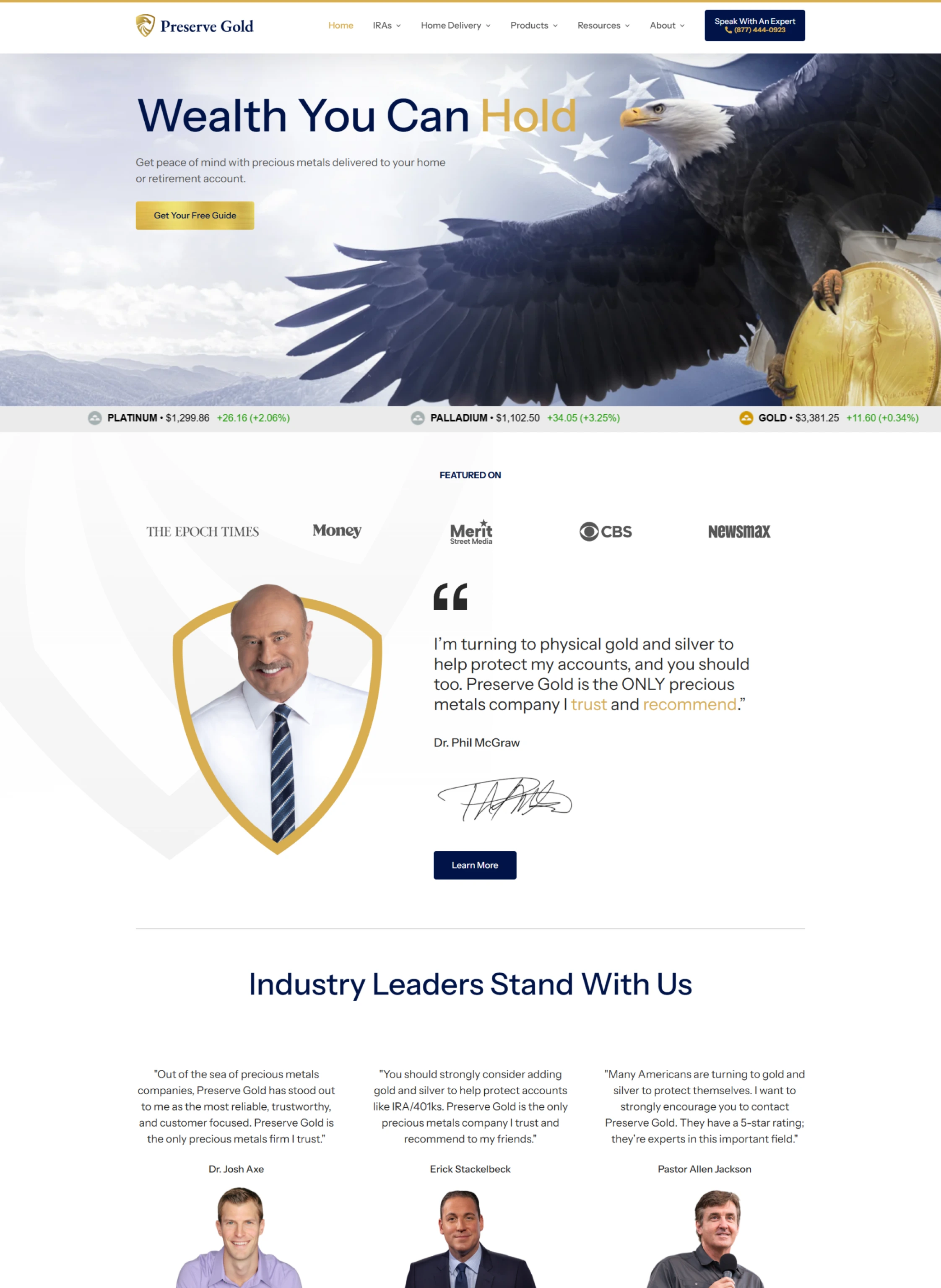
-
Development
- Ecommerce
- Web Development
- Responsive Web Design
- Website Security
- Website Updates
- WordPress
-
And more

- We’re all in on your growth. Explore all of our services.
Development
And more

A strong brand identity is your business’s most powerful storytelling tool. Is yours crafting a narrative that sets you apart?

You can picture that feeling.
The one you’d get when you hand over your business card, pull up your website, or catch a glimpse of your social media profile, and—instead of cringing—you feel proud knowing that your outward visual identity matches the internal values and vision you’ve worked so hard to cultivate.
But right now, it doesn’t.
You’ve either outgrown your logo, colors, and fonts, or they’re placeholders you never got around to actually replacing. You’re worried your messaging isn’t helping you stand out (and stick) in your audience’s minds. Your brand isn’t connecting, but you don’t know why.
That means it’s time to call in a team of experts to untangle your brand’s identity—from its visuals to your unique brand story framework—so you can clarify your mission and message and finally keep moving foward.
And Connective’s team? We’re the non-agency agency that’s ready to jump in and build you the stand-out brand identity you’re looking for.
Custom Brand Identity
This isn’t just about looking good (though we’ll definitely make sure you look incredible). You’re here because you want a cohesive and impactful brand identity that truly speaks to your target audience. And that’s exactly what we’ll do—all without the old-school approach of a traditional agency.
When you partner with Connective, we do more than hand over a logo and a color palette. We help you tell the story of your brand, all before you even get a chance to say a word. When you want to stand out in your industry and connect with the right people, you need a brand identity that does all this:
It’s time to clarify your brand’s purpose, values, personality, and positioning, so your visuals and messaging can help you stand out in the crowd with a unique and memorable style that speaks for itself.
Your branding will be built with research, strategic thinking, and design expertise to resonate with your target audience, all while helping you maintain consistency across touchpoints.
We’ll develop your audience personas and your branding suite so you’ll have everything you need to craft unmistakable interactions with current and future customers from the moment they lay eyes on your brand.
Full brand identity packages begin at $15,000. Inquire now for a custom quote or see our branding package here.

Want to see a few of the branding projects we’ve completed lately? Grab some
popcorn… this show’s gonna be a good one.
We’re the minds behind the innovative and impactful branding for businesses in 20+ industries, from e-commerce and law firms to dental offices, contractors, nonprofit organizations, and even CBD oil brands. Our refined process can get you results like these too, no matter what industry you’re in.

…you need more than just a logo and a color scheme.
You’re looking for a complete brand identity, including audience personas and a brand framework to align your team and guide your marketing strategy.
…you prioritize research and strategy over quick turnarounds.
You understand the importance of data-driven decision-making and expect a thorough analysis of your industry, audience, and competitors to shape your branding.
…you want high standards and a personalized approach—without the red tape.
You’ve experienced the pitfalls of a traditional agency and are ready for a team that offers tailored, client-focused solutions without bureaucracy.

Your Brand, Fully Developed In Just 6 Steps
Our team of experts seamlessly guides you through a refined and collaborative process that culminates with a *very* big reveal: your brand-new brand identity.
The best part? This 6-step process is highly personalized and flexible in a way only a non-agency (branding) agency could pull off. Here’s how it all goes down.
Our partnership starts here! Before we begin developing the concepts (and killer designs) behind your brand strategy, we first start with getting to know you and your business. Your project manager will send you a Discovery Guide questionnaire that will help us learn about your vision and goals. Then we’ll get together at a kickoff meeting to dive deep into all the details so we can go to bat for your brand.
By this point, we’re itching to start strategizing and designing, but we won’t begin until we’ve thoroughly researched your industry, competitors, and target audience. Why? To serve up the best strategy, we need to first identify where your brand will fit and the unique voice it will need. (Psst… that’s the secret to how we create whoa-worthy brands!)
Now comes the *really* fun part (especially for our designers/art team). We develop branding concepts, then develop some more branding concepts, then kick them around internally, and then develop even MORE branding concepts. And we keep iterating until we have created an identity package that nails every single one of your goals.
And this is always *your* favorite part. It’s time for you to see your new branding! We’ll walk you through it all, piece by piece, explaining our design decisions, providing insights into how it reflects your brand’s identity, and listening carefully to your feedback. (Prepare to be blown away!)
We’d never deliver and disappear. We’re not done until your brand identity fully meets your vision and needs. Next up, we’ll refine and revise your chosen branding concept until you’re confident it completely aligns with who your company is—and where it’s going.
Time for the grand finale! We’ll hand over your final branding and identity package that comes with crystal-clear guidelines—no art or marketing degree required to decipher. These materials are designed to be easily understood and implemented by anyone working with you to keep their work on-brand. Which means your brand will look consistently awesome, no matter who’s working behind the screen.

Whether you’re one piece of information away from inquiring or you still aren’t sure if brand design is what you need, we’re here to answer all your questions.
How about instead, we tell you what a good branding agency (*ahem* like Connective) does? A good branding agency will craft a brand identity unique to your business, aligning it with your core values and your audience’s expectations. Our goal is to differentiate your brand from your competitors and make you memorable with your target audience. We go deep into research mode, creatively develop distinct brand personas, and build a cohesive visual and communicative style that will set you apart and resonate with your future customers.
A lot more than visuals, for a start. A typical branding package from Connective includes a comprehensive range of services to establish your brand identity. This can include logo design, brand color schemes, typography, brand voice guidelines, persona creation, and visual imagery. But we don’t stop there. We also provide brand strategy development, which is what really sets you apart. Together, we can define your brand’s mission, vision, values, and personality, as well as create a unique brand story and messaging framework.
We’re not just saying this: Partnering with a branding agency like Connective is definitely worth it. If your goal is to carve out a strong position in the market (and of course it is), investing in brand strategy and design is a very smart move. But, to be frank, that’s only true only if you go beyond a logo and a color scheme. When you choose us, you’re gaining a strategic partner dedicated to translating your business values and vision into a compelling brand story. One that sets you apart from competitors, fosters brand recognition and loyalty, and lays the groundwork for long-term success.
A very common question—let’s clear this up, once and for all! Branding and marketing are both important for business growth, but they do have different roles. Branding is the process of defining your business’s identity, values, and how you want to be seen by others. This includes the strategy behind and creation of your logo, brand colors, tone of voice, and overall personality. Marketing, on the other hand, is how you communicate your brand to the world. It includes tactics like advertising, content marketing, and social media. In short, branding is who you are, and marketing is how you get people’s attention. Both are crucial, but branding is the foundation upon which marketing strategies are built.
In three words? Uncomplicated, collaborative, and transparent. In more words? Our process begins with an in-depth onboarding phase where we learn about your business, followed by market research, strategy development, and creative execution. We involve you every step of the way, not only because we value your input, but also so that we can be responsive to your feedback and ensure that the final brand identity aligns with your vision and objectives.
Where do we even start? A strong brand identity can give your business the boost it needs to grow and keep growing. And it’s more than just visuals—the brand identity our team will develop for you helps your business stay front and center in consumer’s minds and makes sure you stand out from your competitors. Your new brand identity will connect with your target audience and create loyalty and trust. Your marketing efforts will become clearer and more consistent while reinforcing your business’s character and improving recognition. And an added bonus? A strong brand identity can even inspire employees and build team cohesion. (Yes, really.)
Nobody likes to hear it, but… it depends! The cost of services from branding agencies can vary widely, depending on the scope and complexity of your project. At Connective, we tailor our pricing to your needs so that you receive a comprehensive brand identity package that aligns with your business goals and budget. Think of it like a buffet—you can choose what you need and leave the services you don’t. Want to get an idea of what your pricing would be? You can contact us directly for a no-pressure quote that reflects your business’s unique branding needs.
We’re going to answer this question with another (three!) questions. Are you looking to establish a robust and cohesive brand identity for a new business you’re launching, or to rebrand an existing one to strengthen your market position? Does your brand feel disconnected from your target audience or like it needs help to stand out in a competitive industry? Are you undergoing significant changes in your business, such as entering new markets or altering your business model? If you answered yes to any (or all!) of these questions, it’s a clear sign that professional branding expertise is necessary.
This isn’t something you can trust any old branding agency to do. At Connective, we’ve developed an approach to branding that focuses on in-depth research and creative development so that your brand identity looks like no one else. To start? We take the time to learn all about (and we really mean ALL about) your business, industry, competitors, and target audience. Then we use what we learn to create a brand identity that is unique and memorable, resonates with your audience, and differentiates you from your competitors.
It all goes back to how deeply we believe in the power of research. We start our project by understanding your business goals in-depth through our onboarding process and kickoff meeting. We then tailor your branding strategy to support these objectives: market expansion, customer retention, brand awareness, or entering new markets. Our branding efforts are always aimed at creating a visually appealing identity and driving tangible business results. With Connective, you’ll never sacrifice one for the other.
Don’t see your question? We won’t leave you hanging.
A website crafted just for you, from scratch (and with love)
Need a website that’s both beautiful and effective? We’ll create a site that feels like you, draws in your ideal customers, and makes navigating effortless. Think of it as the perfect blend of style and substance—eye-catching, user-friendly, and built to grow your business. Learn more >>
Generate leads, sales, and brand loyalty
Looking for measurable growth through digital channels? We’ve got you! Our data-driven, customer-centric marketing approach includes SEO, paid advertising, social media, email campaigns, and more. We’ll help you generate leads, sales, and brand loyalty—beyond your website. Learn more >>
All your needs covered, all under one roof
Inquire about adding on additional services, from print and trade show designs to video production, website security, ongoing site updates, and more.
A strong brand identity goes far beyond just looking nice. It connects. It resonates. It builds trust. And *that’s* the kind of energy that turns first-time visitors into forever customers.
When you choose to partner with Connective—whether you’re starting from scratch or refreshing an existing identity—you get a highly skilled crew who will blend strategy and creativity into a one-of-a-kind brand identity that can become your business’s most valuable asset.
Your brand is more than just a logo. It’s your story—and it’s time to make it count.
So, Are You In?